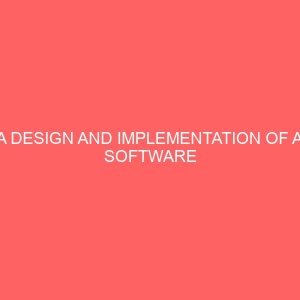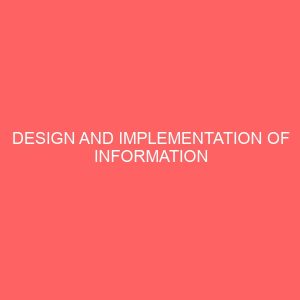Description
ABSTRACT
The aim of this research work is on model architecture for staff promotion and remuneration management system in the private sector. To this end. If tried to trace the history of remuneration of employee is the public sector in Nigeria. The old system used to have seven steps within a grade. The reactions of employees to the new structure and the problems that emanated form the structure and how it affected those in the private sector of the economy are all treated. The researcher equally considered the type of remuneration and fringe benefits available in incomtel Nigeria Limited and how they are been motivating works to increase productivity. The instrument used in the study is ten 10 items. This questionnaire distributed to the employees of incomtel. The questionnaire was divided into two 2 parts; one part was distribution while the other part reflected the opinions of the employees on the management level. The research summed up the information receives from those groups of employees. The outcome formed the major source of information needed to preposition.
CHAPTER ONE
1.0 INTRODUCTION
Remuneration is the compensation that one receives in exchange for the work or services performed. Typically, this consists of monetary rewards, also referred to as wage or salary. A promotion is the advancement of an employees rank or position in an organizational hierarchy system. Promotion may be an employees reward for good performance, i.e., positive appraisal. Before a company promotes an employee to a particular position it ensures that the person is able to handle the added responsibilities by screening the employee with interviews and tests and giving them training or onthejob experience. A promotion can involve advancement in terms of designation, salary and benefits, and in some organizations the type of job activities may change a great deal.
Good remuneration has been found over the years to be one of the policies the organization can adopt to increase their workers performance and thereby increase the organization productivity. Also with the present global economic trend, most employers of labour have realized the fact that for their organizations to compete favourably, the performance of their employees goes a long way in determining the success of the organization. On the other hand the performance of employees in an organization is vital not only for the growth of an organization but also for the growth of individual employees. An organization must now who are its outstanding workers, those who need additional training and those not contributing to the efficiency and welfare of the company.
Throughout the years production has increased for many reasons in addition to the particular motivation and has erroneously over simplified a highly complex phenomenon since the psychologists have been especially concerned with understanding an individual through his motives and acquired a body of knowledge in this field that often differs from the Laymans knowledge is necessary to review briefly from the psychologists point of view what is known about motivation at the present time. In Uganda, effective use of rewards and motivation to influence workers performance begun in 1970s, since then performance of workers has become important due to the increasing concern of human recourses and personal expects about the level of output obtained from the workers due to poor remuneration. This attitude is also a social concern and is very important to identify problems that are met in industrial settings due to nonchalant attitude of managers to manage their workers by rewarding them well to maximize their productivity. All efforts must be geared towards developing workers interest in their job so as to make them happy in giving their best to their work and this will ensure industrial harmony. Vroom 1964 supported the assumption that workers tend to perform more effectively if their wages are related to performance which is not based on personal bias or prejudice but on objective evaluation of an employee on merit. Though several techniques of measuring job performance have been developed in general, the specific technique chosen varies on the type of work. All these issues call research efforts so as to bring focus on how an appropriate reward package can gear up or influence the workers to develop a positive attitude towards their job and thereby increase their productivity.
1.1 BACKGROUND OF THE RESEARCH
Remuneration is directly linked with the time spent or devoted by an employee on the job. The employees are paid a fixed predecided amount hourly, daily, weekly or monthly irrespective of their output. It is a very simple method of remuneration. It leads to minimum wastage of resources and lesser chances of accidents. Time Rate method leads to quality output and this method is very beneficial to new employees as they can learn their work without any reduction in their salaries. This method encourages employees unity as employees of a particular group/cadre get equal salaries.
There are some drawbacks of Time Rate Method, such as, it leads to tight supervision, indefinite employee cost, lesser efficiency of employees as there is no distinction made between efficient and inefficient employees, and lesser morale of employees.
According to Armstrong 2003, good practice requires employers to keep pace with inflation by rewarding employees with salaries that are market related to avoid strikes and poor performance by workers. Organizations are under financial strain with salaries continually rising and becoming a major fixed expense. According to Livingstone 2009, regardless of basic pay inefficiencies, it remains a rule that employees should be paid at, or above market rates as negotiated by labour unions who are concerned with the welfare of employees. In a competitive market, higher basic pay is used for attracting and retaining employees. Otherwise contradicting this rule has negative consequences on the part of the organization. Basic pay communicates commitment to employees, and is used as the baseline for assessin
1.3 OBJECTIVES OF THE STUDY
The objectives of this study were based on the architectural model on staff promotion and remuneration effect and they included the following:
To determine current incentive package the model at which staff promotion and remuneration are rewarded.
To determine the effectiveness of the model architecture on staff promotion and remuneration.
To discover the factors effecting staff promotion and remuneration management
1.4 SIGNIFICANCE OF THE STUDY
The study will, however, try to talk on why it is essential to set a model an architectural scheme for staff promotion and remuneration. This research work will also, serve as a learning tools an academic material to the students and among business ventures.
1.5SCOPE OF THE STUDY
The project work sited here encompasses the model architecture for staff promotion and remuneration. It covers the attempts made in the past on this topic, the successful attempts as well as the failures. Therefore this project research work only covers the project topic specified only.
1.6RESEARCH QUESTION
The research questions will be tailored towards the purpose of the study such that if they are answered, one will clearly realize why model architecture is necessary in the management of staff promotion and remuneration. The questions are the following:
1.What are the current incentive package the model at which staff promotion and remuneration are rewarded
2.How effective is the model architecture on staff promotion and remuneration
3.What are the factors effecting staff promotion and remuneration management
1.7 RESEARCH HYPOTHESIS
This is the tool with which to test the reliability of the subject matter comparing the two variablespromotion and remuneration management independent variable and remuneration management dependent variable. The hypotheses are:
H0 Promotion does not influence remuneration management system
H1 Promotion does influence remuneration management system.
H0 A standard model architecture will help manage the organization remuneration scheme effectively.
H1 A standard model architecture does not help in the management of the organization remuneration scheme effectively.
1.8LIMITATION OF THE STUDY
During the course of performing/researching this project work, the researcher encountered a lot of challenges as well as opposition which ranges from financial constraints, time factor. this factors in their own ways, slowed down the speedy progress of this work that resulted to the researcher not being able to finish the research work on time as is required
Also, within the area of study the researcher was faced with some other forms of constrains that contributed to the limitation of this researcher work, like accessibility to data, information and facts concerning the present study due to some reasons or the other, some not willing to give out information that it is to be within the workers.
1.9DEFINITION OF TERMS
Remuneration is the compensation that one receives in exchange for the work or services performed. Typically, this consists of monetary rewards, also referred to as wage or salary
Promotion is the advancement of an employees rank or position in an organizational hierarchy system. Promotion may be an employees reward for good performance, i.e., positive appraisal.
Architecture: is a structural frame work for building a model/basic upon, it is the foundation of a system or model structurally design to handle and accommodate the work set of the previous system.
Model: a representation of a system based on a concrete object, such that the base will be generally accepted as a standard of operation and code in the system.
1.10 ORGANISATION OF THE STUDY
The arrangement of the research is as follows:
Chapter One:introduction already explained above, statement of the research problems, objectives of the research, research questions, research hypotheses, scope of the study and justification of the study.
Chapter Two: literature review of the study, theoretical framework and empirical research wok.
Chapter Three: research methodology and design that will be used in analysing the data and data populations.
Chapter Four: Data presentation and analysis of the research question from the respondents
Chapter Five: summary and conclusion of the whole research work its achievement and delimit of the work








Reviews
There are no reviews yet.